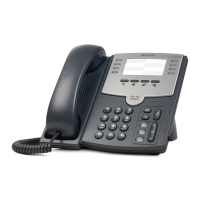Configuring SIP, SPCP, and NAT
Configuring SIP
Cisco Small Business SPA300 Series, SPA500 Series, and WIP310 IP Phone Administration Guide 119
4
Use Outbound Proxy Enables an outbound proxy (for example,
172.20.2.1:5060—port is optional) or a domain name
such as sip.server.com as long as this name is a fully-
qualified domain name. If set to no, the Outbound Proxy
and Use OB Proxy in Dialog fields are ignored.
Defaults to no.
Optionally, the proxy can be configured (Cisco SPA300
or Cisco SPA500 series only) for Survivable Remote Site
Telephony (SRST) support. The proxy is configured with
an extension that includes a statically-configured DNS
SRV record or DNS A record. Configuring the proxy
allows for failover and fallback functionality with a
secondary proxy server. For example:
For SRV Record:
sip.server.com:SRV=node1.sip.server.com:5060:p=1:w=5
0|node2.sip.server.com:5060:p=2:w=50
NOTE Set "Use DNS SRV" to no and "DNS SRV Auto
Prefix" to no.
For A Record:
sip.server.com:A=172.20.2.1,172.20.2.2
NOTE Set "Use DNS SRV" to no and "DNS SRV Auto
Prefix" to no.
Outbound Proxy SIP outbound proxy server where all outbound requests
are sent as the first hop.
Use OB Proxy In Dialog Select yes for SIP requests to be sent to the outbound
proxy within a dialog. This field is ignored if:
• Use Outbound Proxy is set to no
or
• Outbound Proxy is blank
Defaults to yes.
Register Enables periodic registration with the proxy. This
parameter is ignored if a proxy is not specified.
Defaults to yes.
Parameter Description

